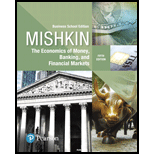
a. The money supply, the currency deposit ratio, the excess reserve ratio, money multiplier.
b. Effect of the above said ratios on money supply.
c. To the effect on
d. Co-relate the scenario of low lending with that of amounts got from excess reserves, the excess reserve ratio, the money supply and the money multiplier.
Concept introduction:
Money supply: This is supposed to be the deposited amount from the customer.
Money multiplier: This depicts the number of times the total money is supplied or deposited into the commercial bank. Whenever there is a deposit, the number of times of money supply increases.
Explanation of Solution
a. The calculation of money supply is as follows:
Therefore, the money supply is $1500.
Calculation of Currency deposit ratio:
Therefore, the currency deposit ratio is 0.667.
Calculation of Excess reserve ratio:
Therefore, the excess reserve ratio is 0.1667.
Calculation of money multiplier:
Therefore, the money multiplier is 2.43.
b. From the given example, it is clear that the new money injected through $1400 billion is put in checkable deposits as central bank pay by checks to banks issuing bonds. This results in an increase in money supply by $1400 billion.
Now, the new money supply
The effect on the money supply can be concluded by stating that there is an increase in the money supply as the new money supply is $2900 billion.
c. To calculate the excess reserve ratio, we need to calculate excess reserve:
Therefore, the money supply is $1500.
Now we need to calculate the money multiplier:
d. From the above calculation, it is clear that money multiplier reduced to 0.744 which is below 1 when bonds were purchased by the Fed. The same thing happened after 2008 also. So, the money multiplier has become less than 1.
Want to see more full solutions like this?
Chapter 17 Solutions
Economics of Money, Banking and Financial Markets, The, Business School Edition (5th Edition) (What's New in Economics)

 Principles of Economics (12th Edition)EconomicsISBN:9780134078779Author:Karl E. Case, Ray C. Fair, Sharon E. OsterPublisher:PEARSON
Principles of Economics (12th Edition)EconomicsISBN:9780134078779Author:Karl E. Case, Ray C. Fair, Sharon E. OsterPublisher:PEARSON Engineering Economy (17th Edition)EconomicsISBN:9780134870069Author:William G. Sullivan, Elin M. Wicks, C. Patrick KoellingPublisher:PEARSON
Engineering Economy (17th Edition)EconomicsISBN:9780134870069Author:William G. Sullivan, Elin M. Wicks, C. Patrick KoellingPublisher:PEARSON Principles of Economics (MindTap Course List)EconomicsISBN:9781305585126Author:N. Gregory MankiwPublisher:Cengage Learning
Principles of Economics (MindTap Course List)EconomicsISBN:9781305585126Author:N. Gregory MankiwPublisher:Cengage Learning Managerial Economics: A Problem Solving ApproachEconomicsISBN:9781337106665Author:Luke M. Froeb, Brian T. McCann, Michael R. Ward, Mike ShorPublisher:Cengage Learning
Managerial Economics: A Problem Solving ApproachEconomicsISBN:9781337106665Author:Luke M. Froeb, Brian T. McCann, Michael R. Ward, Mike ShorPublisher:Cengage Learning Managerial Economics & Business Strategy (Mcgraw-...EconomicsISBN:9781259290619Author:Michael Baye, Jeff PrincePublisher:McGraw-Hill Education
Managerial Economics & Business Strategy (Mcgraw-...EconomicsISBN:9781259290619Author:Michael Baye, Jeff PrincePublisher:McGraw-Hill Education





